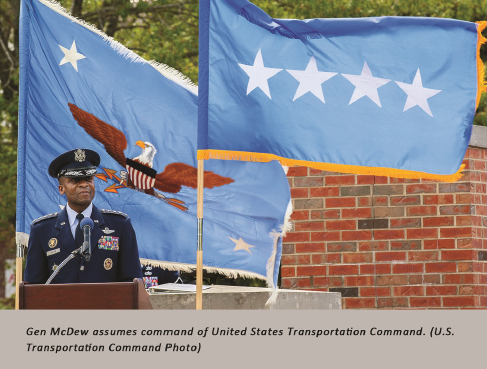Think you know logistics? How would you handle the specialized global logistics needs of a world super power and economic behemoth; their humanitarian, government, and military logistics needs? Those needs are indeed gargantuan in scope, but USTRANSCOM makes it happen 24/7/365, and they make it look routine. Consider the following occurring every day: 3
- 1,235 railcars loading/enroute/off-loading
- 170 ships underway plus 38 ships loading or off-loading
- 190 airlift sorties
- 70 operational air refueling sorties
- Aircraft takeoff or landing every two minutes, 45 seconds
- 10,000 ground shipments per week4
- Operations in 75% of the world's countries4
Considering a single piece of freight could weigh from a few ounces to 100 tons, that's a huge challenge. The US Transportation Command is the biggest Logistics operation you've never heard of. How do they do it?
After 32 years in the Air Force I had participated in many USTRANCOM missions. They are the behind-the-scenes enabler that choreographs complicated logistics challenges. Without the rapid response, force delivery systems of USTRANSCOM, the military would be a local force; unable to project power. Indeed, according to General McDew, Commander of USTRANSCOM, in a recent speech to staff: "Your ability to deliver an immediate force tonight and a decisive force when needed is a unique capability and significant strategic advantage..."1 (my italics for emphasis).

USTRANSCOM's total wartime capability consists of a diverse force: 45,945 active duty; 73,058 Reserve and Guard, and 19,104 civilian personnel. USTRANSCOM's force of Soldiers, Sailors, Airmen, Marines, Coast Guardsmen, DOD civilians and commercial partners accomplishes a wide array of logistics missions. With its people, trucks, trains, railcars, aircraft, ships, information systems and infrastructure, as well as through their commercial partners providing 1,203 aircraft and 379 vessels in the Civil Reserve Air Fleet (CRAF) and Voluntary Intermodal Sealift Agreement (VISA), respectively, USTRANSCOM provides the U.S. with the most responsive strategic mobility capability the world has ever seen.
CIVIL RESERVE AIR FLEET
Airlines have a long history of contributing to the needs of their nation, and in the US this is reflected in Civil Reserve Air Fleet, CRAF. Having worked at a major airline, I distinctly recall our participation in this program and hosting audits by the DoD as described below. Having been deployed overseas many times with the Air Force, I clearly remember seeing all those civilian tails mixed in with the military aircraft at locations off-limits to typical civilian flights. Many of you have likely contributed to the needs of airlines supporting such operations.
Here are some details2 about the CRAF:
As of April 2017, 24 carriers and 434 aircraft are enrolled in CRAF. This includes 397 aircraft in the international segment (267 in the long-range international section and 130 in the short- range international section). There are 37 aircraft assigned to the national domestic services segment. These numbers are subject to change on a monthly basis.
The airlines contractually pledge aircraft to the various segments of CRAF, ready for activation when needed. To provide incentives for civil carriers to commit aircraft to the CRAF program and to assure the United States of adequate airlift reserves, the government makes peacetime DOD airlift business available to civilian airlines that offer aircraft to the CRAF. DOD offers business through the Charter Airlift Services in support of the Civil Reserve Air Fleet contract administered by USTRANSCOM.
To participate in the international segments of CRAF, carriers must maintain a minimum commitment of 40 percent of its CRAF capable passenger and/or cargo fleet. Aircraft committed must be U.S.-registered and carriers must commit and maintain at least four complete crews for each committed aircraft.
Safety is the paramount concern, and numerous procedures are in effect to ensure that the air carriers with which DOD contracts afford the highest level of safety to DOD passengers. Prior to receiving a contract, all carriers must demonstrate that they have provided substantially equivalent and comparable commercial service for one year before submitting their offer to fly for the Defense Department. All carriers must be fully certified Federal Aviation Administration carriers and meet the stringent standards of FAA regulations pertaining to commercial airlines (FAR Part 121).
Additionally, a DOD survey team composed of experienced pilots and skilled maintenance personnel performs an on-site inspection of the carriers. This team conducts a comprehensive inspection that includes the carrier's aircraft, training facilities, crew qualifications, maintenance procedures and quality control practices. Following the on-site inspection, the Commercial Airlift Review Board approves the carrier to provide charter airlift services before receiving a contract.
The DOD Commercial Airlift Division monitors the carrier's safety record, operations and maintenance status, contract performance, financial condition and management initiatives, summarizing significant trends in a comprehensive review every six months. In addition to this in-depth review, there are several other surveillance initiatives. These include safety preflight inspections of commercial aircraft by DOD designated inspectors and periodic cockpit observations on operational flights by highly experienced pilots from AMC's (Air Mobility Command) DOD Commercial Airlift Division. This Division maintains close coordination with the FAA for the sharing of safety information on all DOD approved carriers.
The following air carriers are current members of the Civil Reserve Air Fleet program (subject to change monthly).
International Segment - Long Range
- ABX Air
- Air Transport International
- American Airlines
- Atlas Air
- Delta Air Lines
- Federal Express Airlines
- Hawaiian Airlines
- Kalitta Air Cargo
- National Air Cargo Group dba National Airlines
- Omni Air International
- Polar Air Cargo
- United Airlines
- United Parcel Service
- Western Global
International Segment - Short Range
- Alaska Airlines
- Delta Air Lines
- JetBlue Airways
- Lynden Air Cargo
- Miami Air International
- MN Airlines dba Sun Country
- Northern Air Cargo
- United Air Lines
- USA Jet
National Domestic Services Segment
- Allegiant
- Southwest Airlines
- Tatonduk dba Everts Air Cargo
I know there are many ASA members and accreditees who participate in government/DoD programs. That logistics world (as distinguished by the civilian world) is ruled by a myriad of unique Orders, Instructions, Manuals, FAR's (Federal Acquisition Regulations) and DFARs (Defense FARs). You've likely participated in USTRANSCOM programs and were not aware of it. Make it happen.
Over 'n out
Roy Resto
AIMSolutionsConsulting.com
1 United States Transportation Command Strategy; A Plan for Our Future
3 Email to Resto from Michael P. Kleiman, Commander's Action Group, U.S. Transportation Command; dated 11/7/17.

